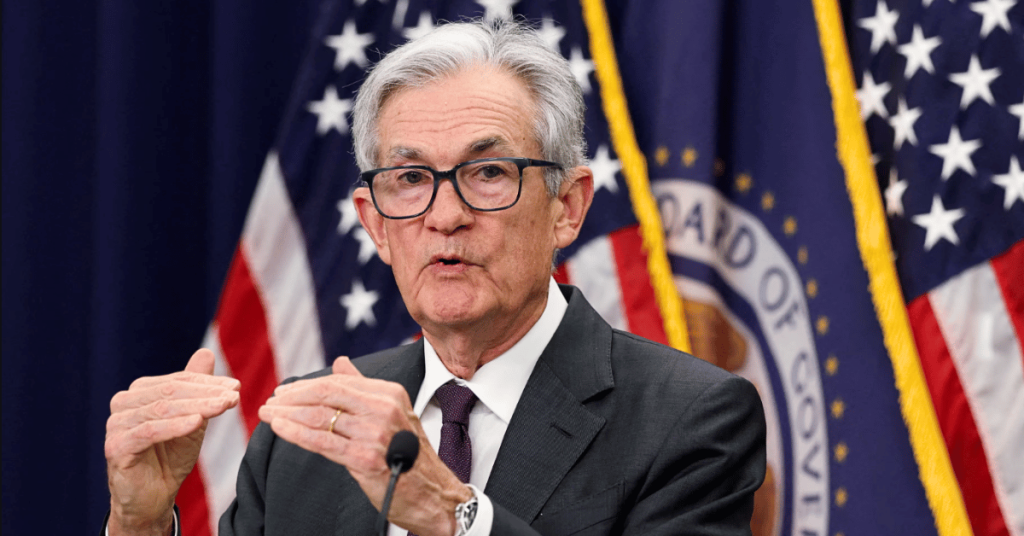
As August begins, markets face key events that could shift risk sentiment — from new US tariffs and central bank moves to trade shifts and supply concerns. With slowing momentum and diverging inflation trends, this week may prove pivotal for FX, equity, and energy markets.
KEY INDICATORS
Market moves: FX, equities, and commodities
Sterling fell to a 10-week low (~$1.3316) after a US–EU trade deal lifted the dollar.
The dollar firmed as Fed Chair Powell maintained a hawkish tone, diverging from other central banks.
Oil prices rose in early August on tightening OPEC+ supply and strong demand forecasts.
Copper hit a record high as new US tariffs (10–41%) on imports took effect on 1 August.
Gold fell as rising bond yields, and a strong dollar reduced safe-haven demand.
Global equity momentum slowed, with the MSCI ACWI stalling after four weekly declines.
HSBC warned of risks to the US equity rally, citing high yields, inflation, and valuation fatigue.
Asian equity markets closed mixed as investors awaited US trade and central bank signals.
Central banks: diverging paths and cautious shifts
Markets expect the Bank of England to cut rates by 25 bps on 7 August as inflation hits 3.6%.
The ECB likely ended its easing cycle, while the Fed held rates with internal dissent.
The Reserve Bank of Australia delayed further cuts but faces pressure to act in August.
South Africa’s central bank held rates, reflecting mixed signals on inflation and growth.
The Bank of Japan signalled possible tightening later in 2025 amid wage and price growth.
Global policy and trade tensions
The US imposed new tariffs on copper and other imports from 69 countries starting 1 August.
Global trade tensions intensified as reciprocal tariff measures were announced.
Australian policymakers face renewed pressure as markets forecast a 3.60% cash rate by mid-2026.
Political uncertainty and tariff risks remain key drivers of volatility across regions.
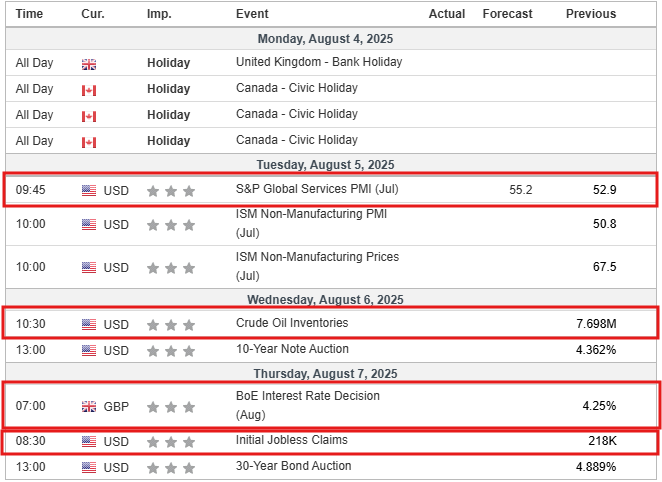
MARKET MOVERS
USD/JPY
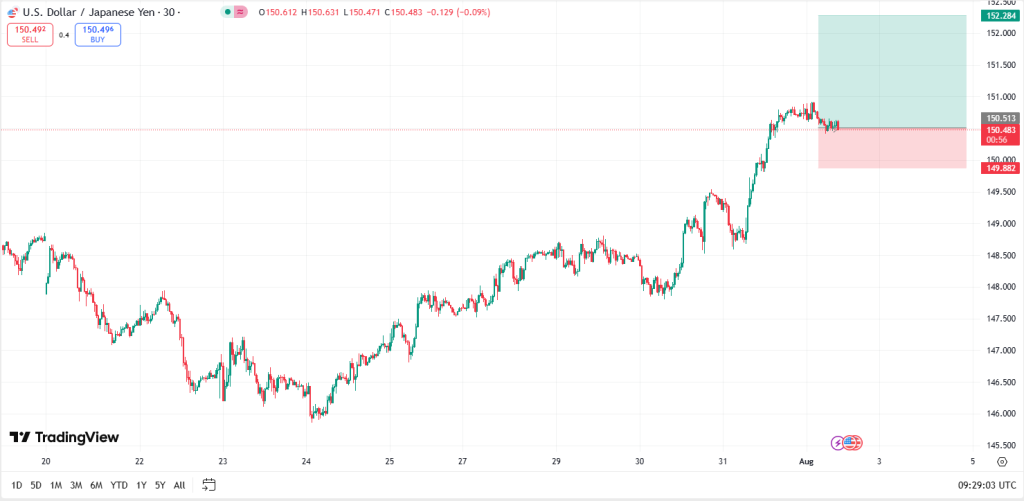
- Technical breakout: USD/JPY has cleared the 149.17–149.20 resistance zone and moved above the 55-day EMA (~145.90), reinforcing the bullish trend. A confirmed close above 151.22 (61.8% Fibonacci) would signal further upside momentum, while failure to hold above 147.50 may prompt consolidation.
- Target projection (bullish): A breakout above 151.22 opens the path to 156.50–156.80, with long-term projections suggesting potential extension beyond 157.00.
- Target projection (bearish): A break below 147.50 may lead to a pullback towards 145.35, with broader downside risk if key supports fail.
- Opening expectation: USD/JPY is expected to open near 150.50–150.60, supported by BoJ policy tone and strong US macro data reinforcing Fed rate resilience.
- Primary support zone: 149.75–149.50 (short-term pivot and channel base).
- Secondary support zone: 147.50–147.80 (key corrective area and 55-day EMA).
- Tertiary support zone: 145.35 (major trigger level that would invalidate the broader bullish structure).
- Strategy (bullish approach): Buy on confirmed breakout above 151.22 with targets at 156.50 and 156.80+.
- Strategy (bearish approach): Short on break below 147.50 with targets at 145.35 and 144.00.
- Stop-loss level: Below 149.40 for bullish positions; above 151.50 for bearish setups.
- Key catalysts this week: US jobs report (NFP), Fed commentary, BoJ policy remarks, and developments around global tariffs.
- Market context: USD/JPY remains in a strong uptrend, but August seasonality often favours yen strength. Traders should manage risk carefully, as upcoming macro events may trigger volatility and short-term reversals.
EUR/USD
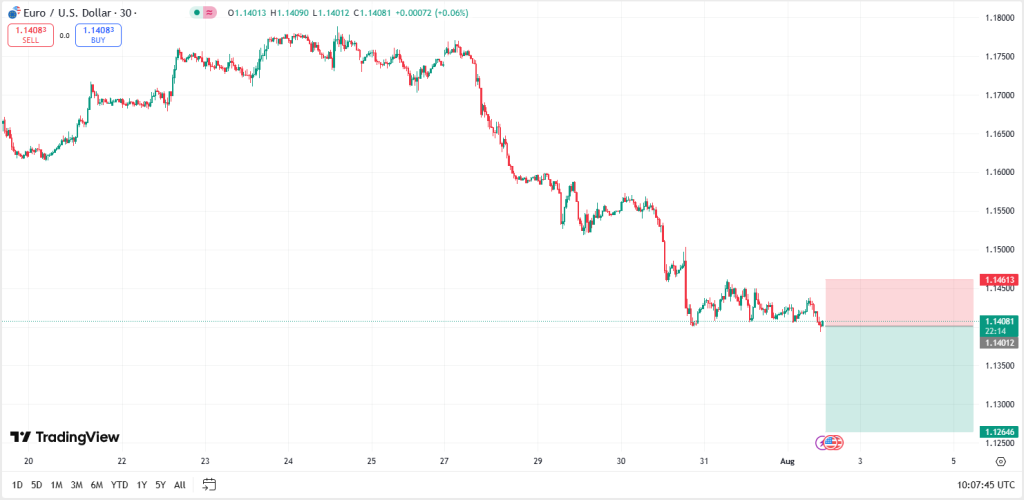
- Technical breakout: EUR/USD has broken below the 1.1500 level and remains under the 50-day EMA (~1.155), confirming bearish momentum. Reclaiming the 1.1550–1.1598 zone is needed to neutralise the bias, while a sustained drop below 1.1380 would confirm further downside.
- Target projection (bearish): A move towards 1.1380–1.1400 is expected near term. A break below this opens the path to 1.1266 and potentially 1.1180, aligned with the 38.2% Fibonacci retracement of the rally from 1.0176 to 1.1829.
- Target projection (bullish): A recovery above 1.1550 could lead to gains towards 1.1600–1.1650, with potential extension to 1.1788–1.1829 if sentiment shifts strongly.
- Opening expectation: EUR/USD is likely to open around 1.1420–1.1440, continuing the bearish pressure seen in late July.
- Primary support zone: 1.1380–1.1400 (key pivot level).
- Secondary support zone: 1.1266 (Fibonacci retracement).
- Tertiary support zone: 1.1180 (long-term structural support).
- Strategy (bearish approach): Short below 1.1520 targeting 1.1380, 1.1266, and possibly 1.1180.
- Strategy (bullish approach): Buy above 1.1550 targeting 1.1600, 1.1650, and 1.1829.
- Range play: Trade between 1.1380 and 1.1550 by buying near support and selling near resistance, using tight stops.
- Stop-loss levels: Above 1.1520 for bearish positions; below 1.1490 for bullish setups.
- Key catalysts this week: US non-farm payrolls and unemployment data, Eurozone PMIs and inflation figures, trade deal developments, and ongoing macroeconomic trends impacting USD and EUR sentiment.
- Market context: EUR/USD remains pressured amid broad USD strength driven by trade deals and macro data. Euro bulls face headwinds from position unwinding, but key technical levels may offer short-term trading opportunities.
XAU/USD
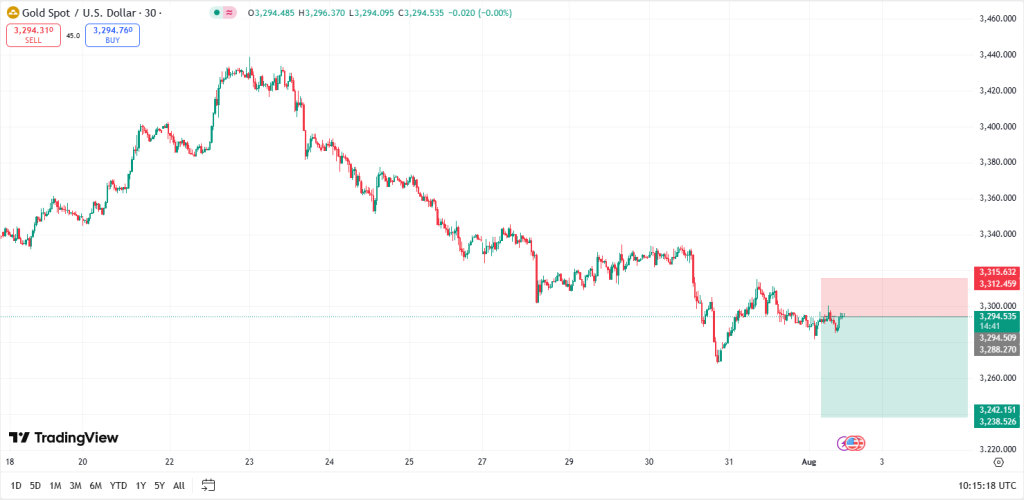
- Technical breakout: Gold remains under pressure below the key $2,380 resistance level, failing to reclaim its short-term trendline. The technical bias stays bearish unless the price closes decisively above $2,400. A breakdown below $2,320 would confirm bearish continuation.
- Target projection (bearish): A move below $2,320 exposes support at $2,300, followed by $2,275. If selling accelerates, a deeper target near $2,240 becomes likely.
- Target projection (bullish): A rebound above $2,380 could retest $2,400. A breakout beyond $2,410 may pave the way towards $2,435–$2,450, requiring strong macro support such as falling yields or geopolitical tensions.
- Opening expectation: Gold is expected to open around $2,340–$2,345, continuing recent range-bound behaviour under pressure from a firm dollar and rising US bond yields.
- Primary support zone: $2,320 (short-term pivot).
- Secondary support zone: $2,300 (prior swing low).
- Tertiary support zone: $2,275–$2,240 (deeper support based on trendline extensions).
- Strategy (bearish approach): Sell on a break below $2,320 with targets at $2,300, $2,275, and $2,240; stop-loss above $2,385–$2,390.
- Strategy (bullish approach): Buy on a rebound above $2,380 targeting $2,400 and $2,435; stop-loss below $2,310 to manage risk.
- Range play: Trade within $2,320–$2,380 by buying dips near support and selling rallies near resistance with tight stops.
- Key catalysts this week: US non-farm payrolls and bond market direction will heavily influence gold via real yields. Continued dollar strength and expectations of the Fed staying on hold are bearish. Geopolitical shocks or dovish surprises from central banks could reverse sentiment quickly.
- Market context: Gold remains pressured by a strong dollar and rising yields, but geopolitical risks and central bank policies may create volatility. Traders should apply disciplined risk management.
NEWS HEADLINES
Geopolitics and trade risks
IMF warns that global trade tensions and inflation remain major threats despite a slight upward revision in growth forecasts.
The US imposes new tariffs of 10% to 41% on imports from Canada, India, Switzerland, and Taiwan, effective 1 August.
US Senator Roger Wicker plans a visit to Taiwan, increasing tensions between Washington and Beijing.
Iran threatens to close the Strait of Hormuz, raising fears of global oil supply disruptions.
Currency and macroeconomic shifts
The US dollar strengthens after new trade deals with the EU and Japan reduce tariff-related uncertainty.
India faces pressure as new US tariffs highlight both its vulnerability and strategic role in global supply chains.
Emerging market currencies weaken as risk-on flows favour the stronger dollar.
The Bank of Japan signals a tightening bias as inflation nears 2.9%, prompting policy shift speculation.
Commodities and global markets
Oil prices remain range-bound as geopolitical risks are offset by OPEC+ supply increases.
Gold declines under pressure from rising US bond yields and a firmer dollar.
Global equities retreat as investors react to new US tariffs and overvalued market conditions.
HSBC warns that high yields, slowing tech momentum, and Fed credibility issues could stall the US stock rally.
Asian stocks fall across Japan, China, and Taiwan as tariff fears hit sentiment before earnings season.
Click here to open account and start trading.





